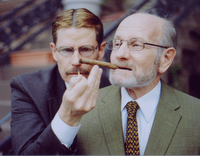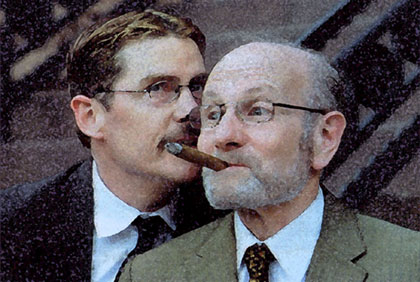FREUD AND JUNG, AND FALLING IN LOVE
on
by Ken Wydro
One of the subjects that has opened up for me while writing the original drama SECRETS is the whole chemistry of “falling in love.” I recently heard the old American standard song, “I Fall In Love Too Easily.” I fall in love too fast. I fall in love so terribly hard for love to ever last. The Kenny Rankin version. Amd it seemed to me that that is what happened to Freud and Jung, as well as so many millions of others – heterosexual, homosexual, bisexual – since then.
What happens when, seemingly suddenly and out of the blue, someone walks into our lives and – bingo! There is a chemistry, an electricity, a sense of magic and mystery, of the Right Person materializing out of almost thin air. There follows a period of play, of can’t –wait- to- be- with- each- other, of making plans in wonderfully charged midnight conversations. Something had been missing your whole life long, a deep part of you not quite complete, and then – whew! Everything seems clear. Everything seems right. All the pieces seem to be falling into place.
Then, you go away, far away from everybody else, on a honeymoon, a long voyage to another country where you are with each other nearly twenty-four hours a day. And something happens – a word, a phrase, a revealing emotional outburst, a quick flash of insight into the other side of the person, the shadow side, which throws the entire fantasy into a different light.
Perhaps there was a secret revealed, or passionate denial or severe defense of a minor point. You begin to see aspects of the other person that were hidden or kept under wraps until now, and you wonder – what else is hiding under there? What issues and sore points will be happened upon tomorrow?
Sometimes, like with Sigmund Freud and Carl Jung, the divorce proceedings actually begin on the honeymoon when there is not much to do but to be with each other. This happened in August and September of 1909 when Freud and Jung were invited to speak to receptive colleagues at Clark University in Worcester, Mass. Their dangerous game was to analyze each other’s dreams – both had a knack and a talent for seeing the symbolic nature of dreams in their patients – yet when it came to questioning or interpreting each other’s inner life, there emerged a split and a difference that could never be bridged again - for example - Freud’s dream about Minna (his sister-in-law) amd Martha ( his wife) followed by Jung’s dream about the two skulls. Freud refused to answer Jung’s basic psychoanalytic questions about his dream while Jung believed that Freud consciously or unconsciously misinterpreted the significance of bringing the two skulls up into the light.
The rift between Freud and Jung took more than three years to finally play out, slowly and painfully as if connective tissue were being pulled apart inch by inch. The mental, artistic and spiritual fibers that had grown so strong between then came apart, one by one as it were, each feeling as if something were being torn out strand by strand.
Although both were masterminds and innovative thinkers in their own right, when it came to each other, both were blind, uneasy and ineffectual. The end of their “affair” was deeply depressing to both, especially Carl Jung who had driven the divorce, partly to become his own man and travel his own road.
So, what can we make of all this? What can be gleaned from the witnessing of such a train wreck that almost everybody saw coming? Can we reach a better understanding about the chemistry of “falling in love” by gaining some insight into the Freud-Jung “affair.”
What was really going on here, anyway?
Actually, some of the ideas and theories of Freud and Jung do shed great light on the mystery of falling in love so easily, falling in love so fast. While investigating and exploring the nature and the structure of the psyche, especially the realm of the unconscious, both Freud and Jung began to postulate the notion of projection, the idea of seeing in someone else what you want him or her to be. As with most psychological terms and conditions, a projection takes place when certain conditions are present, ripe as it were.
One of the clearest descriptions of the relationship between projection and falling in love can be found in the book INVISIBLE PARTNERS by John Sanford who paints a clear picture of why, let’s say, a 55 year old man who has a wife and grown children and is extremely successful in business will one day, beyond all reason, fall head-over-heels in love with a cute and perky 26 year old female he meets at some office party and then become willing to give it all up for her, placing everything he has worked so hard for, and for so long, in total jeopardy.
Or why, an otherwise balanced and stable 38 or 40 year old woman is suddenly taken by the new minister of the church, or a swarthy contractor who has been hired to do construction on the deck of the house, arranging secret, private rendezvous’ with the ever-present dangers of being caught in the act.
In both cases, the “roving” man or woman begins to felt that the new character on the scene is the perfect one to fill something that that has otherwise remained unfulfilled – that this person will bring love, excitement, adventure and a new lease on life. With a near vengeance, the one who is projecting will pursue, demand and create situations to be with the new lover, until the new paramour on the scene begins to feel stalked, boxed in and totally restricted. What seemed to be perfect, the ideal finally becoming real, inevitably becomes dangerous, tortured, devastating and impossible to maintain
And this is where the Freudian/Jungian notions come into play. Freud postulated that all human are to some degree bisexual in that each person has a blend of both masculine and feminine tendencies and capacities. Since the man most often identifies with the male body and gender, he values and develops the “masculine” tendencies while the feminine capacities get pushed down and back into the unconscious.
After years and years of being a man, of fighting and winning and planning and strategizing for victory – winning is not everything, it is the ONLY thing – the repressed feminine side wants some way out, some means of expression. Almost like a jack-in-the-box, that feminine side, so long neglected and undervalued,
will pop up and demand some attention. That need, that pressure, finds a release in a person on the outside. The repressed need becomes projected on to a real live person when it is really a manifestation of an inner imbalance,
So, that 55 year old man sees in the available, beautiful and attentive young lady the embodiment of what he has repressed for so many years, his feminine side. His dreams and his needs come true. He looks for on the outside what can only be really answered from within, usually with disastrous consequences.
In this light, that is what happened to both Freud and Jung. Freud, in his mid-50s, had had a long, tough and rocky road in trying to establish is ideas and methods to mainstream medicine and therapy. He wanted and needed a shining young knight to carry his banner into the war of credibility and prominence. Jung was tall, energetic, charismatic and, above all, receptive to Freud’s fields of study and innovation.
For his part, Jung was ready and able to play the role of star actor delivering the lines of the master playwright. In Freud, Jung saw the father he never had, the master choreographer who would design the performances exactly for the gifted dancer. They at first saw in each other the perfect partner, the one to build a future upon. Each stimulated, inspired and energized each other with new possibilities.
Until. Until the fantasy and the projection ran into reality. The inner, underlying truth – the constellation of complexes with each of them – began to wear on each other and on themselves.
The break up was as inevitable as the parting of the ways of the 55 year old executive and the 26 year old love toy. After a while, they rubbed each other the wrong way, although it must be noted that Freud made numerous attempts to patch up the differences. In the end, the adopted son had to leave the home of the famous father, or else live in his shadow forever.
Ironically enough, it was Emma Jung, Carl’s faithful and deeply tested wife, who wrote about projection in her work on the Animus and Anima. Maybe in order to make some sense of the role of her husband in the deeply provocative “affair” with Sigmund Freud.
What Freud and Jung remained faithful to until the end, however, was the idea that the unconscious side of an individual always plays into everyday life in an intimate and deep way. In order to understand who you are, and why you do what you do, you must turn within to recognize, examine and ultimately embrace those events and issues of the past.
Jung was to call this turn within in order to better understand yourself “The Heroic Journey.” In SECRETS, we catch a glimpse of the two masterminds trying to master themselves. Maybe we can begin to understand why . . . why . . . why did he . . . why did I do THAT?



0 Comments:
Post a Comment
<< Home